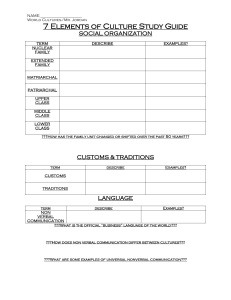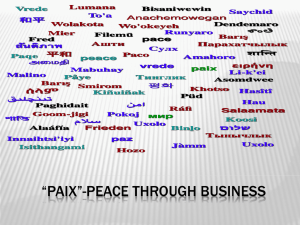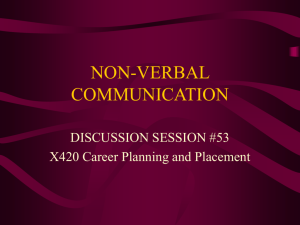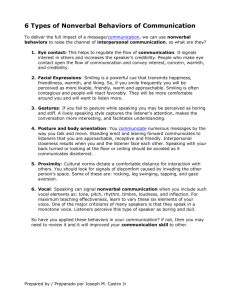File
advertisement
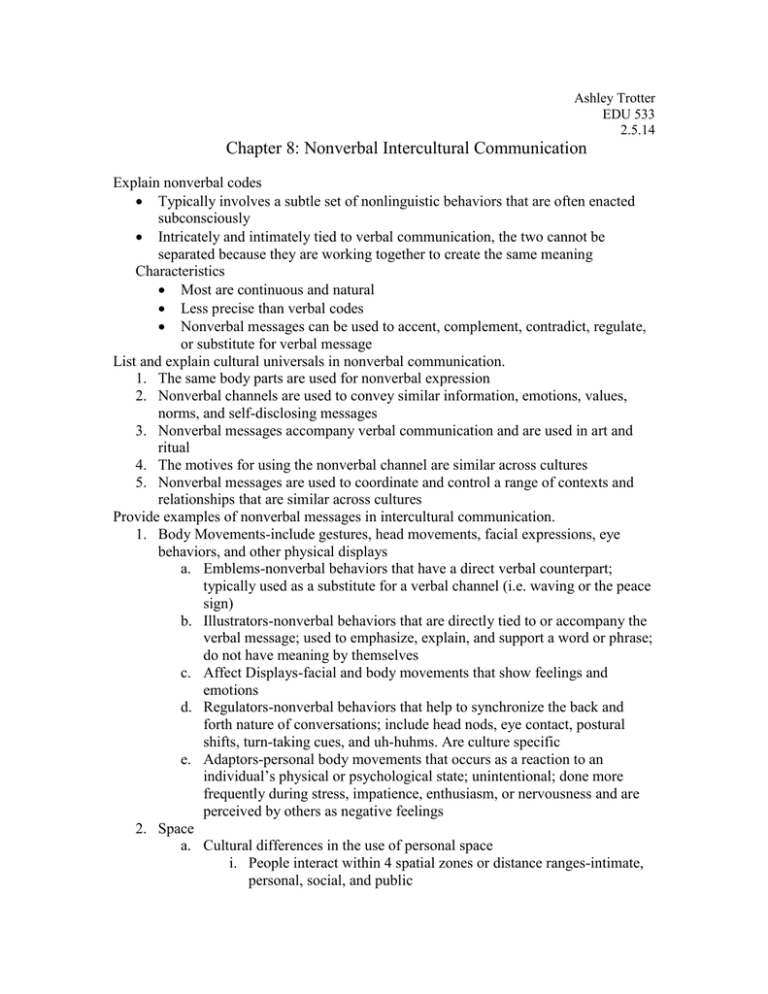
Ashley Trotter EDU 533 2.5.14 Chapter 8: Nonverbal Intercultural Communication Explain nonverbal codes Typically involves a subtle set of nonlinguistic behaviors that are often enacted subconsciously Intricately and intimately tied to verbal communication, the two cannot be separated because they are working together to create the same meaning Characteristics Most are continuous and natural Less precise than verbal codes Nonverbal messages can be used to accent, complement, contradict, regulate, or substitute for verbal message List and explain cultural universals in nonverbal communication. 1. The same body parts are used for nonverbal expression 2. Nonverbal channels are used to convey similar information, emotions, values, norms, and self-disclosing messages 3. Nonverbal messages accompany verbal communication and are used in art and ritual 4. The motives for using the nonverbal channel are similar across cultures 5. Nonverbal messages are used to coordinate and control a range of contexts and relationships that are similar across cultures Provide examples of nonverbal messages in intercultural communication. 1. Body Movements-include gestures, head movements, facial expressions, eye behaviors, and other physical displays a. Emblems-nonverbal behaviors that have a direct verbal counterpart; typically used as a substitute for a verbal channel (i.e. waving or the peace sign) b. Illustrators-nonverbal behaviors that are directly tied to or accompany the verbal message; used to emphasize, explain, and support a word or phrase; do not have meaning by themselves c. Affect Displays-facial and body movements that show feelings and emotions d. Regulators-nonverbal behaviors that help to synchronize the back and forth nature of conversations; include head nods, eye contact, postural shifts, turn-taking cues, and uh-huhms. Are culture specific e. Adaptors-personal body movements that occurs as a reaction to an individual’s physical or psychological state; unintentional; done more frequently during stress, impatience, enthusiasm, or nervousness and are perceived by others as negative feelings 2. Space a. Cultural differences in the use of personal space i. People interact within 4 spatial zones or distance ranges-intimate, personal, social, and public ii. People from colder climates use large physical distances when communicating, those from warmer climates prefer close distances iii. Cultural spacing impacts the level and comfort of sensory information-too close can smell the breath, too far cannot hear b. Cultural differences in Territoriality i. Cultures differ in general degree or territoriality that its members tend to exhibit ii. Cultures differ in the range of possible places or spaces about which they are territorial iii. Cultures differ in the typical reactions exhibited in response to invasions or contaminations of their territory Describe/explain cultural meanings of touch, time, and voice. 1. Touch a. The Meanings of Touch i. Affect-the expression of positive and negative feelings and emotions ii. Playfulness-behavior should not be taken seriously iii. Control-can indicate social dominance iv. Ritual-generally involves introductions or departures v. Task-related activities b. Cultural Differences in Touch i. High contact cultures touch each other more in social conversations ii. Cultures differ about where it is appropriate to touch someone iii. Cultures differ about who can touch them iv. Cultures differ regarding the settings or occasions in which touch is acceptable 2. Time (chronemics) a. Time Orientations-value or importance members of a culture place on passage of time i. Past oriented cultures-previous experiences and events are most important; emphasis on tradition and respect for elders; events are circular ii. Present-oriented cultures-emphasis on spontaneity and immediacy and experiencing every moment; fate or luck control their lives iii. Future-oriented cultures-current activities are done for future benefits; makers of their own fate b. Time systems-implicit cultural rules that are used to arrange sets of experiences in some meaningful way i. Technical Time-precise, scientific measurements of time; little relevance to ordinary citizens ii. Formal Time-way members describe and comprehend units of time iii. Informal Time systems-assumptions cultures make about how time should be used or experienced 1. Monochronic-things should be done one at a time and time is segments into precise, small units; time is a commodity; expected beginning and ending times that have been scheduled in advance 2. Polychronic-several things are being done at the same time, relationships are more important than schedules, and multiple appointments are often scheduled at the same time 3. Voice a. Vocal vs. Verbal Communication i. Vocalic qualities include pitch, rate of talking, conversational rhythm, and volume b. Cultural Differences in Vocal Communication i. Vocal stress and intonation differences may be perceives as aggressive or abrasive when only polite conversation is intended. Application When going into a situation where there are going to be different culture groups it is beneficial to learn about those different cultures. This will eliminate a lot of frustrations and confusion. It’s important to be aware and understanding of the culture’s time and space orientations and to no get offended when they differ from yours. Biblical Links 1 Corinthians 4:7 For what makes you different from anyone else? What do you have that you did not receive? And if you did receive it, why do you boast as though you did not? This passage simply means that everything we have and are is a gift from God. This means that we did nothing be born into the family or country we were born into and neither did anyone else. Therefore we are not to judge or condemn others but see their differences and perspectives as an opportunity to learn and grow.
